FCT COMBUSTION NEWSLETTER: October 2022

Dear Friends,
I hope this newsletter finds you happy and healthy, as we enter the final quarter of 2022.
Over the past year, there have been many changes at FCT. We have opened a new office in China, we have actively participated in various academic and industry research consortiums into hydrogen and emerging fuels, and we have entered new strategic partnerships to deliver the best possible solutions for our customers.
Additionally, the past year has brought an increasing number of enquiries about our clay calcining technologies, and we have made headway into new projects to assist our valued customers in adopting green cement production. Our team has more than 4 decades of experience in working with calcined clays, and has been able to offer their expertise in analyzing clay samples and offering advantageous solutions for our customers based on the results.
Offering both FlashCalx™ flash calcining technology and RotaCalx™ rotary kiln calcining solution, we are pleased to be a trusted partner for our clients’ needs in this field. We have been pleased to share our knowledge on this topic at various industry conferences recently, while simultaneously enjoying the opportunity to again to meet our associates, friends, and customers in person.
In July, Technical Director Pedro Ladeira presented “Activating Clay to Help Achieve CO2 Emissions Goals by 2050” at Cemtech Asia. If you missed this presentation, the recording is available for viewing by clicking here.
Over the next few months, we will also be presenting at Cemento Verde 2022, as well as at SEMTEC – Technical Congress for the Cement and Lime Industry. More information is available by clicking here. We look forward to meeting you there!
I hope that you will enjoy reading our latest newsletter, and please do not hesitate to contact our team anytime if we can be of help. You can contact us via our contact page or follow us on LinkedIn
Wishing you all the best,

Adriano Greco
FCT Group CEO
PROJECTS ACROSS THE GLOBE
RECENTLY COMPLETED OR CURRENTLY ACTIVE PROJECTS ACROSS FCT COMBUSTION INCLUDE:
AUSTRALIA: BHP Olympic Dam
FCT is delivering an oxy-fuel burner package for BHP’s flash smelting furnace at Olympic Dam in South Australia. The upgrade will extend the life of the furnace. In addition to the custom burners for both the North and East walls of the Settler Bath, accompanying burner management systems, valve trains, oxygen analysers and ancillaries are also included within the scope.
AUSTRALIA: Albermarle, Kemerton
FCT has delivered and is commissioning the combustion system and gas analyser to Metso: Outotec’s lithium plant in Kemerton, WA.
BRAZIL: Undisclosed client
FCT has been awarded the contract to supply a new vertical hot gas generator in Brazil. The supply comprises the complete 52 MW hot gas generator including the burner, fuel oil valve train, fuel oil pumping and heating skids, igniter system and the components to safely operate the system. The new HGG will combust fuel oil and coal to generate hot gases at controlled temperatures to supply thermal energy to a rotary dryer.
BRAZIL: Vale, Vitoria
FCT has delivered 196 burners to Vale’s iron ore pelletizing plant in Vitoria. The scope also included valve trains, flame sensors, igniters, gas analysers, flow meters and various other equipment to convert the kilns to natural gas and improve operational safety. Commissioning of 46 burners and equipment for Kiln 3 is complete, with commissioning of burners and equipment for subsequent kilns to follow later this year as scheduled in accordance with planned stoppage and availability.
Burners and valve trains being manufactured for Vale in Brazil
BRAZIL: Icon Máquinas, Criciuma
FCT has been awarded the contract to supply 3 new hot gas generators to Icon Máquinas in Criciuma, for which the final customer is Vale’s New Steel project. Two of the natural gas fired Hot Gas Generators will be installed in the Vitoria plant, and the third Multi-Fuel equipment will be installed in Vargem Grande, MG. All Hot Gas Generators will be supplied in partnership with Icon, who will integrate the equipment to their dryers.
BELGIUM: Cimenterie CBR, Lixhe
FCT delivered a hot gas generator with accessories and control system. The hot gas will be used to preheat raw material as part of an expansion of the EU H2020 Leilac (Low Emissions Intensity Lime & Cement) Pilot for CO2 emission reduction. Commissioning is expected to take place during the second half of 2022.
CANADA: Undisclosed client
FCT has delivered a new hot gas generator to an undisclosed customer in Canada. The supply comprises the complete hot gas generator including the burner, valve train, igniter system and the components to safely operate the system. The new HGG will combust natural gas to generate hot gases at controlled temperatures to supply thermal energy to a rotary dryer. Commissioning is planned to happen in the next months.
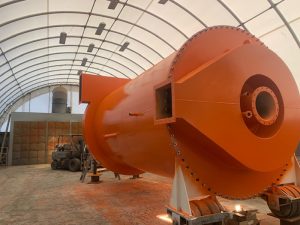
FCT has delivered a hot gas generator to a client in Canada
CANADA: Lehigh Hanson, Picton
FCT has delivered a set of K-Jet burners to be installed in the Calciner of the Picton plant in Ontario, Canada. The K-Jet burners were designed to fire natural gas.
CAMEROON: Undisclosed client
FCT has delivered a complete fuel oil system for a calciner and a hot gas generator, from truck unloading pumps to valve trains inlet. The scope includes tanks, filtering, pumping and heating stations. Commissioning is expected to take place towards the end of 2022.
FRANCE: HeidelbergCement, Bussac Foret
FCT has been awarded a contract by DAL Engineering Group to deliver a Turbu-Flex™ burner for HeidelbergCement’s Bussac Foret plant. The targets of the project are to maximise the use of alternative fuels as well as to improve combustion control. Commissioning is expected for the beginning of 2023.
GERMANY: HeidelbergCement, Hannover
FCT will commission a Turbu-Flex™ burner for HeidelbergCement’s Hannover plant in Germany, following the successful commissioning of a separate Turbu-Flex™ burner at the company’s Burglengenfeld plant earlier this year.
The targets of the project are to maximise the use of alternative fuels as well as to improve combustion control. The supply also included accessories and add-ons to the burner, as well as igniter, flame sensor, fans, blowers, BMS and spare parts. Commissioning is expected for the second half of 2022.
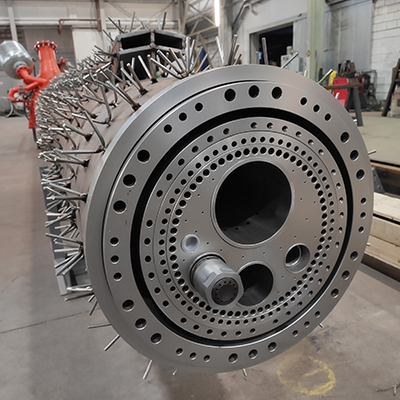
A Turbu-Flex™ burner was recently delivered to HeidelbergCement’s Hannover plant.
HONG KONG: Green Island Cement
FCT delivered a Turbu-Flex™ burner and trolley for Green Island Cement’s kiln to reduce NOx emissions by 15% and reduce fuel consumption whilst maintaining existing clinker quality.
JAPAN: Sumitomo Mining & Metals
FCT has commissioned a burner to Sumitomo Mining & Metals in Japan, for ferro-nickel reduction application. The burner will ensure a high degree of flexibility in heat flux profile to allow for scale-up in the future as the client’s needs change and grow.
NAURU: Republic of Nauru Phosphate Corporation (RONPHOS)
RONPHOS has two rotary dryers for drying phosphate rock, each with its own hot gas generator. FCT has delivered a combustion system including one oil burner, a primary air fan, an oil pumping skid, an oil valve train, and Burner Management System. The combustion system is designed to utilise both waste oil and diesel. Commissioning is expected for March 2023.
OMAN: Vale, Sohar
FCT has commissioned a Gyro-Therm™ burner for iron ore pelletizing grate-kiln application at Vale’s plant in Sohar, Oman.
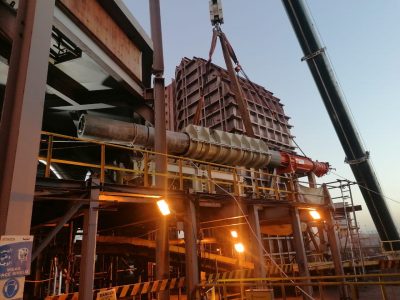
FCT has delivered a Gyro-Therm™ burner to Vale’s iron ore pelletizing plant in Oman.
TURKEY: Cimentas Kars, Kars
FCT has commissioned a burner upgrade for the Kars plant, to a Turbu-Jet+ design to allow for higher momentum and to improve combustion of hard-to-burn fuels including petcoke, in challenging operating conditions.
USA: Lhoist, Clifton
FCT has been awarded the contract to supply a Gyro-Therm burner to Lhoist´s Clifton plant in Texas. The supply also comprises the valve train, igniter system and BMS to safely operate the system. The new burner will be able fire up to 100% coal and 100% natural gas, improving plants operational flexibility with the ability to fire different fuels.
USA: Texas Lime Co., Cleburne
FCT has been awarded a contract to supply a new dual-fuel Gyro-Therm™ burner for the Cleburne plant in Texas. The new main burner can fire up to 100% coal and 100% natural gas. The supply includes the accessories and add-on to the burner, as well as igniter, flame sensors, fans, and burner trolley.
USA: Mississippi Lime, St Genevieve
FCT has been awarded a contract to supply a new dual-fuel Gyro-Therm™ burner for the St Genevieve plant in Missouri. The new main burner can fire up to 100% coal/petcoke mix and 100% natural gas. To complete the burner system, FCT will supply an automatic natural gas fired pilot, and a NFPA 86 compliant valve train for the safe start up and shut down of the natural gas.
USA: Ash Grove Cement, Chanute KS
FCT has completed the commissioning service of the new Turbu-Jet™ for the cement kiln in Chanute Plant. The new Turbu-Jet™ burner system is able to fire up to 100% coal/petcoke, natural gas and 40% liquid waste.
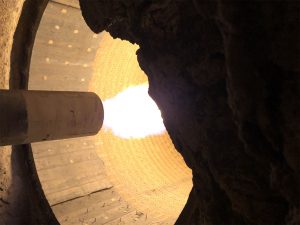
Multi-fuel Turbu-Jet™ burner being installed at Ash Grove’s Chanute plant.
USA: Lhoist, Natividad
FCT delivered a set of equipment designed to improve the plant’s reliability and safety. After an audit, a new igniter, flame sensors, valve train components and BMS were provided to bring the plant to most recent safety and compliance regulations.
USA: Ash Grove Cement, Leamington
FCT has been awarded a contract to supply a set of K-Jet Calciner burners and a warm-up burner for Ash Grove’s Leamington plant in Utah. The burners will improve the mixing and heat distribution when operating with natural gas. To complete this engineered solution, a dedicated safety gas valve train for the safe start up, control and shut down of natural gas will be supplied, as well as a new Calciner BMS system.
USA: Ash Grove Cement, Durkee
FCT delivered a Gyro-Therm™ burner to Ash Grove Cement’s Durkee plant in Oregon. The burner is a second unit, delivered complete to the customer, aiming to minimize maintenance time during outages.
USA: US Silica, Vale OR
FCT has been awarded the contract to supply a safety system upgrade for kiln 1 installed in US Silica’s plant in Oregon. The project aims to update the existing natural gas valve train to comply with the latest NFPA safety requirements, including new ignition system. A new burner management system will also be installed.
UNDISCLOSED COUNTRY/CLIENT
FCT has delivered 11 Gyro-Therm™ burners to an undisclosed client in Eastern Europe. The burners were delivered across 6 of the client’s cement plants, with the main target being to reduce specific fuel consumption. The burners are designed to fire natural gas and solid alternative fuels. Control systems, igniters, igniter valve trains, flame sensors, and accessories were also included within the scope. At this stage, two of the burners have successfully been commissioned, with the others scheduled to follow.
UNDISCLOSED COUNTRY/CLIENT
FCT has delivered a set of 20 natural gas burners for an iron ore pelletizing plant. The scope also includes valve trains, flame sensors, igniters, flow meters, fans, local control boxes and spare parts. Commissioning is scheduled for 2023.
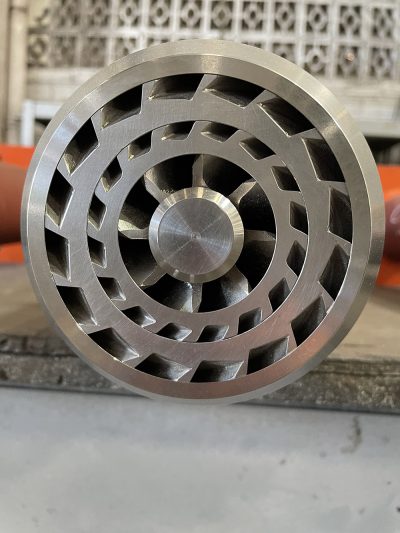
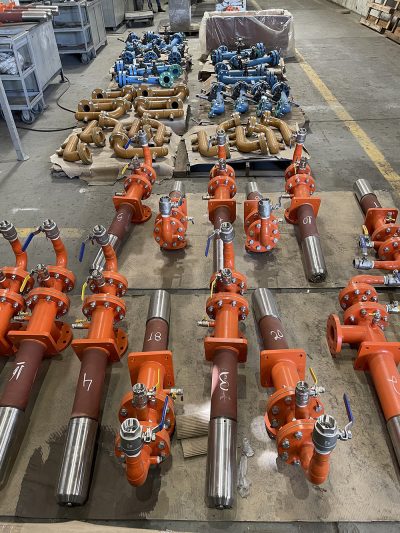
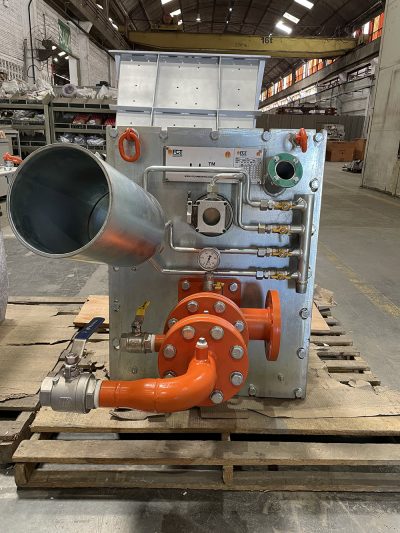
FCT has delivered combustion equipment for an iron ore pelletizing plant.
PEOPLE OF FCT
At FCT, we know that our continued success is largely due to our team’s commitment to providing the best products, service, and expertise across all our offices. In this edition, we are pleased to celebrate Senior Process Engineer, Nader Qamar, as he reaches a milestone anniversary with FCT.
Nader is the Senior Process Engineer at FCT’s Asia-Pacific office, located in South Australia. Nader holds a Ph.D. in Combustion and Chemical Engineering from the University of Adelaide, and prior to joining FCT he worked in the oil and gas industry.
Due to COVID restrictions last year, we were not able to celebrate Nader’s 15 year anniversary with the company, but this year, the team was able to meet in person and celebrate this impressive milestone! We are very pleased to have Nader’s skills and experience on our team.
We learn some more about Nader in the interview below.
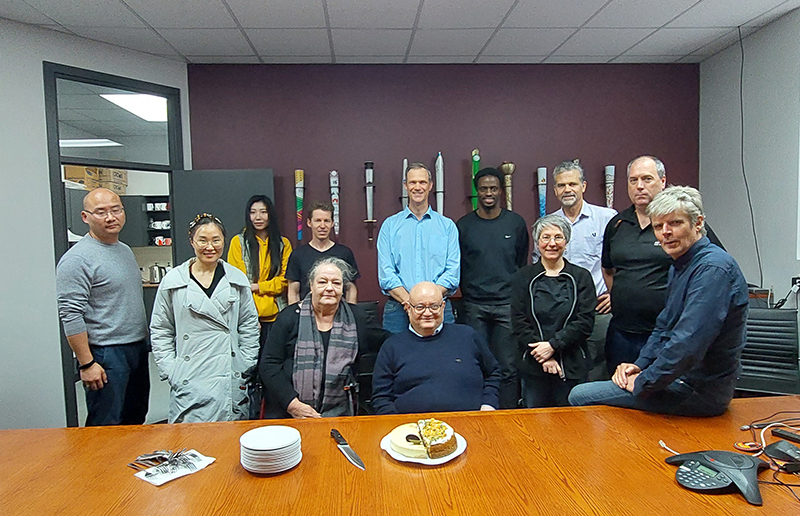
Nader Qamar (front, centre) with some of the team from the Australian office on his anniversary.
Can you tell us a little about your role?
I am a Senior Process Engineer at FCT. My role includes the design of combustion equipment, burner management systems and fuel handling systems, the commissioning of supplied equipment, consulting on projects and supporting the CFD team, as well as supporting the sales team in the preparation of technical proposals. While I primarily work for the Combustion division of FCT, I also participate in the design and commissioning of ceremonial flames for our sister company, FCT Flames.
What are you most passionate about in your role?
FCT is unique in having the same process team carrying out the design as well as the commissioning of the equipment, so it is always very exciting to get to see the burner, or the valve train that I designed, in operation. At FCT we also get exposed to many industries ranging from cement and lime, to iron ore, lithium, titanium, etc. It is intriguing to work across different projects, and over the years, it has enabled me to develop expertise across various industries.
What has been a highlight of your time with FCT?
More than one occasion or event! Working on an Olympic Games such as the Vancouver Winter Olympics, and the Beijing Summer Olympics, was unforgettable. Also, visiting places around the world that I couldn’t have visited otherwise.
What have you seen change in the industry since you began your career, and what do you look forward to seeing in the future?
There has certainly been more focus on burning alternative fuels, especially in the cement industry, and there has also been tighter emission limits. We have developed technologies to assist our customers in successfully reducing their emissions.
In the Australian FCT office, many of our clients are large mining and mineral processing companies, which naturally requires strict focus on documentation and safety aspects. A more thorough approach of safety through the application of Functional Safety: Safety Instrumented Systems for Process Industry Sector as per IEC 61511 is becoming the norm for many clients and we are happy to assist our clients in achieving this.
With our customers in the cement industry, we have also seen a shift toward decarbonization using calcined clay as a clinker replacement. This strategy has already been in use for more than 40 years in some parts of the world, but it has become more mainstream recently.
CONFERENCES & EVENTS
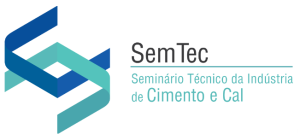
SEMTEC – Technical Seminar for the Lime and Cement Industry being held in Belo Horizonte, Brazil from October 25-27.
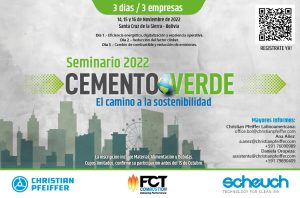
FCT will give a presentation and participate at Cemento Verde 2022, being held from November 14-16 in Santa Cruz de la Sierra, Bolivia. To register, please use the QR code before October 15, 2022.

Blaz Jurko will attend INTERCEM Americas from December 5-7 in Houston, Texas, USA.

We were pleased to attend Cemtech Europe 2022 this month, where Joel Maia gave a presentation on the topic “Calcined clays – from science to practical cases

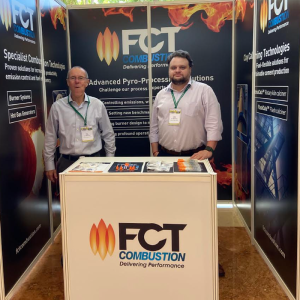
Paulo Mazzei presented “Emisiones CO2 y Calcinación de Arcillas y Pozolanas” at XXXVIII FICEM 2022 Technical Congress held in Cancún, Mexico from September 5-7. FCT also exhibited at Booth #79 at the event, and it was a pleasure to meet all our friends, customers, and associates again!
Clay Calcining Q&A
Green cement production is one of the strategies being considered by the global cement industry to reduce carbon emissions and simultaneously deliver economic benefits to producers. FCT have developed FlashCalx™ and RotaCalx™ specialist clay calcining technologies to assist producers in achieving these benefits, as well as developing a proprietary solution to ensure the traditional ‘cement grey’ colouring is maintained in the final product.
Our expert team have a combined four decades of experience in clay calcining. Here, they answer some common questions about the material, the process, and the technology.
Cement is a crucial industry for the ongoing development of infrastructure globally, but the traditional cement production process creates approximately 8% of the world’s man-made carbon emissions.
The landmark Paris Agreement, supported by 196 countries across the world, strives to limit global warming to less than 2°C above pre-industrial levels. This has triggered a push to adopt stricter regulations to reduce greenhouse gas emissions by signatory countries.
Particular attention is being paid to industrial processes due to their energy intensive nature, which can have environmental impact on a broad scale. Additionally, this high use of energy can create economic inefficiencies for the producers themselves.
Green cement, so named for its environmental benefits, is regarded as a more sustainable solution with far reaching impacts by reducing the CO2 emissions and overall fuel consumption.
The move to green cement has been proven to:
- Significantly decrease emissions levels associated with cement production.
- Reduce operational costs for producers as less thermal energy is required.
Retain a high standard product for consumers with the potential for added benefits such as enhanced durability and increased plasticity within the concrete.
In Portland Cement production, pulverised limestone is a main ingredient in the raw mix, along with sources of silica, aluminium, iron, and other components. The mix is then pyro-processed at 1,450°C to produce clinker, the rock-like material that is ground down into powder and is the main constituent of cement.
During pyro-processing, the raw material is decarbonated, which is a necessary path to produce the cementitious mineral compounds in clinker resulting in significant CO2 emissions. Additionally, there are also CO2 emissions that vary according to the fuel source used to heat the raw materials to such high temperatures.
In the production of Green Cement, Supplementary Cementitious Material (SCM), processed between 600°C and 900°C, are used as a partial substitute for clinker in the final cement making process. Green Cement retains the cement strength of Portland Cement, and in some cases even improves plasticity. As in compound cement, less clinker is used and less heat is required to produce artificial SCM, less CO2 is emitted in the production process.
SCM can be defined as amorphous silico-aluminous material with hydraulically binding characteristics. There are various types of SCM that can be used in green cement, including natural volcanic materials, limestone, industrial by-products such as fly ash and slag, as well as natural or synthetic pozzolans.
As natural gas has become less expensive, and in response to the international CO2 reduction targets, power station operators are moving away from coal firing, which has resulted in both the reduced availability and increased price of fly-ash. Slag is also in high demand and not readily available anymore. As a result, pozzolans have become very popular SCM sources for green cement production, although suitable deposits of natural pozzolans can be scarce in some regions and challenging to access.
In such cases, or where uniformity is desired, synthetic pozzolans including calcined clay have become the premier choice of SCM. Clay is readily available virtually everywhere and deposits tend to be very heterogeneous, but clays used as pozzolans typically need Al2O3 to be in the range from 17% to 38%. The content of sand and other impurities can vary enormously, usually in a range from 5 to 50% and can include significant levels of iron oxide Another point to be considered is the moisture levels which can vary between 5 and 75%, depending on the source of the clay.
While Portland Cement is high in Calcium based compounds, pozzolan is chiefly a siliceous material, as demonstrated in Figure 1. Several types of clay can be used as SCMs after activation, with kaolinite, illite and montmorillonite being the most common types. Fineness of the clay after drying can range from a few micrometers to a few milimeters.

CaO-SiO2-Al2O3 ternary diagram. Portland Cement is shown as “CP”, and pozzolan is indicated by “P”
The activation of clay pozzolans are heavily dependent on three basic factors:
- Mineralogical composition of clay
- Crystallinity
- Optimal calcination temperature
The main aim of the industrial processing of pozzolans is to remove hydroxyl from the clay structure (as opposed to removing the carbon dioxide from the limestone structure in clinker production), and this process leads to the activation of alumina and silica oxides.
It is important to note that a low calcination temperature will not activate the clay completely and an excessive calcination temperature can cause the recrystallization of the clay structure, as shown in Figure 2. Both cases substantially decrease the reactivity of the clay. Of the clays mentioned, kaolinite is the easiest to work with because it has the widest temperature range for successful calcination. Some other clays, including montmorillonite, have a much smaller range at which they can be precisely heated to achieve activation before recrystallization occurs.

Thermogravimetric and differential scanner calorimeter analysis shows the temperature window for calcination before recrystallization occurs
Two of the most common methods for the industrial processing of pozzolans are via suspension calciner (also known as a flash calciner), or via rotary kiln. FCT has developed versions of each of these technologies in the form of FlashCalxTM and RotaCalxTM, based on our team’s extensive experience working with calcined clay technologies for more than four decades. Having these two products in its portfolio, FCT is an unbiased partner to find the best solution in each specific project, to each specific client, each specific set of constraints and especially with each specific type of clay.
The heating process that the clay is submitted to in both technologies is similar, however each method has its own particularities, advantages, and disadvantages. Trade-off studies should be conducted, and individual projects evaluated with their own specifics and particular costs, to find the best solution on a case-by-case basis.
A key factor for consideration is the characterisation of the clay. For example, flash calcination is usually preferred for clays with a very small and precise calcination temperature window. However, for clays with very hard particles, a rotary kiln would be the better option due to the longer residence time.
Other important factors for consideration include the intended processing amount, whether the plant is greenfield or brownfield, whether there is a call to integrate or repurpose existing equipment, available footprint, the fuel type(s) to be used, and the available budget.
Figure 3 demonstrates the different factors that could influence selection when evaluating the best method for processing SCM. To download the map in full size, please visit here
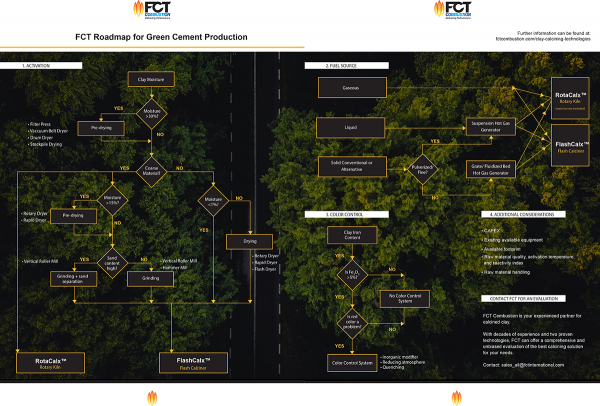
Various factors can influence whether flash calcining or rotary calcining is the most suitable solution for a given material.
FCT has developed FlashCalx™ technology, a flash calciner for the thermal treatment of clay which results in a highly reactive pozzolan for green cement. Generally, the use of a flash calciner is acknowledged to be the ideal solution for greenfield plants as opposed to a rotary kiln, as in most cases, the flash calciner solution can offer faster return of investment.
Characterised by quick start, easy operation, and a small footprint, FlashCalx™ is available in various sizes with either a separate line or inline calciner depending on the client’s needs. The system allows for hot gases to be recycled at various points, resulting in reduced fuel and heat consumption. An increase in up to 20 on strength development has also been reported when the flash calciner based SCM is used as part of a blended cement.
Before it can be fed into the FlashCalxTM, the clay must be a dry, fine powder. To achieve this, the raw material must be dried down to 1% moisture through either a flash dryer, rotary dryer, or similar, depending on the moisture content, electric energy consumption, footprint, and other factors.
Although clays are by nature a fine material, a dryer-grinder may instead be necessary and should be carefully selected based on the moisture and composition of the material. The installation of a grinder can also provide other benefits, including the ability to remove inert material such as sand removal prior to injection into the flash calciner, which would reduce specific thermal energy requirements and maintenance.
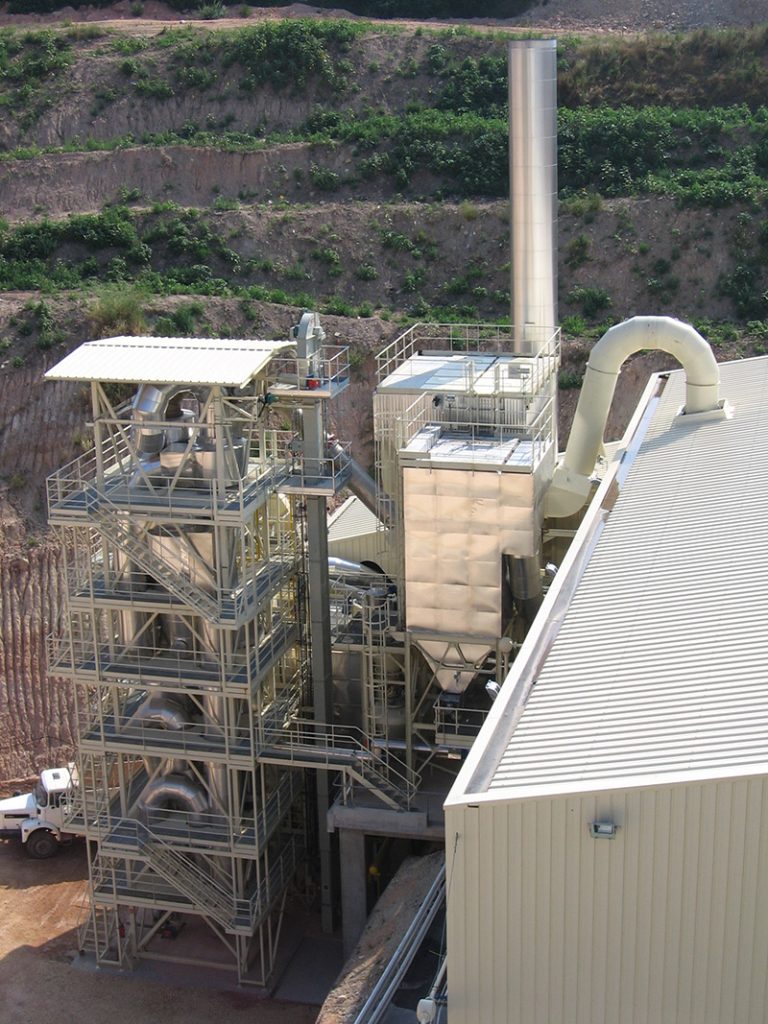
FCT’s FlashCalx™ technology is a suspension calciner for the thermal treatment of clay
In the beginning of the process, the first two cyclones on the top of the tower are used for heating the calcined clay. A bucket elevator is used to feed the fine clay to the top of the tower. The elevator can also be used to create the recirculation of clay in the tower, especially during the preheating process, thereby virtually eliminating off-spec material.
After the material is fed into the flash calciner, the target is to increase the temperature of the clay to the required calcination temperature which is material specific. Heat transfer is achieved through intimate contact between the hot gases and the fine clay particles, creating improved heat recuperation for the system when compared to a rotary kiln. An induced draft process fan controls the transport in the preheat/calcination sections, while a baghouse filter is applied for dedusting. The gases coming out from the flash calciner installation can then be reutilised to dry and grind the raw clay, further decreasing thermal consumption.
An innovative hot gas generator provides extreme fuel flexibility for the client to use the most readily available, preferred, or cost-effective fuels. The hot gas generator fires not only traditional fuels such as natural gas, fuel oil and pulverised fuel, but also solid fuels without need for grinding, including lumpy coal/petcoke and alternative fuels such as biomass and RDF/SRF.
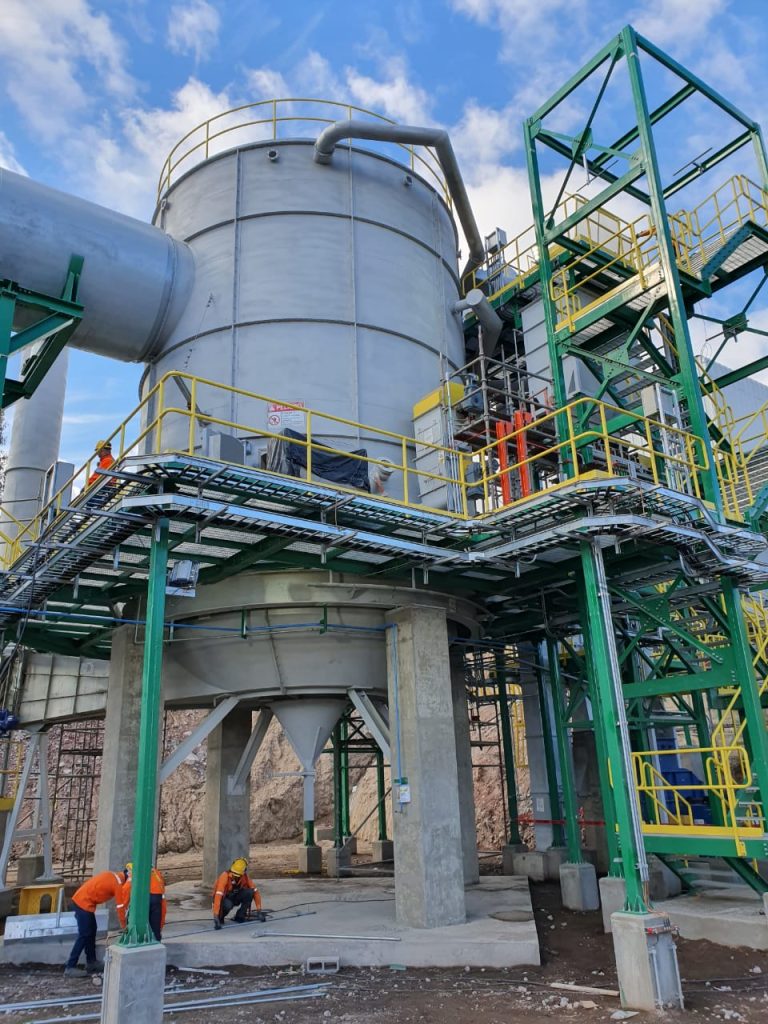
The installation of a state-of-the-art hot gas generator provides extreme fuel flexibility
Dihydroxylation of the clay is achieved between the calciner riser and calciner cyclone. The reaction temperature is easily controlled by a temperature-fuel PID loop, normally ranging from 600°C to 900°C depending on the characteristics of the clay. As mentioned, the ability to control the temperature within a narrow window is key, especially for more temperamental clays such as montmorillonite, so that recrystallisation does not occur.
Refractory is only applied in the combustion chamber, riser and calciner cyclone, which makes heating faster, less expensive and provides the ability to re-start the system from cold condition within 1-2 hours. Through FlashCalxTM all material is transported either through pneumatic conveying or gravity, translating to a low maintenance, low weight, and high reliability installation.
Once the reaction is complete, the product arrives at a set of cooling cyclones which are responsible for decreasing the calcine temperature while recovering heat to both the hot gas generator and raw meal drying. Gas flow in the cooling section is controlled by another process fan, which allows for separate control between the preheating/calcination section and the cooling section of the calciner, adding more flexibility to the system.
Finally, the product is pneumatically or mechanically conveyed to the product silos or directly to the finish mill separator to be blended with cement. As FlashCalxTM easily controls and prevents the melting and agglomeration of the clay, the calcine has a high specific surface area, which leads to a highly reactive pozzolan with none or minimal requirement for finish grinding.
RotaCalxTM is FCT’s rotary kiln solution for clay calcining, suitable for both greenfield plants as well as brownfield projects where a kiln may have been mothballed previously and some equipment still exists.

Clinker rotary kilns can be effectively repurposed for clay calcining application, and FCT engineers have extensive experience with this dating back to the 1980’s. Existing parts of kilns or dryers can be matched and integrated with new equipment to complete the design and supply with reduced capital costs.
Although homogenous granulometry is required to achieve homogenous calcination, rotary calcining allows for a coarser feed material to be utilised due to longer residence time in the kiln. For clays with higher moisture content RotaCalxTM allows operators to directly feed the material to the back of the kiln. This can result in reduced costs associated with pre-processing, since there is no need for grinding and drying of the material prior to injection in the kiln.
A wide range of fuels can be used, and multiple fuel types can be fired simultaneously. Rotary calcining can also be a desirable option for operators who wish to use fuels that are lighter in weight, such as fluff or sawdust, that may be less suited to use in hot gas generators installed as part of a flash calcining plant.
Table 1 provides a comparison of the two discussed calcined clay technologies.

Q8: What strategies are in place to control the colour of calcined clays in green cement production?
In the past, a key challenge to commercialisation of green cement has been the ability to keep the traditional cement grey colouring, as the iron (Fe) content often found in clay can result in the product being a reddish hue depending on how it combines to oxygen (O).
Although the colour of the cement does not correlate with any issue of quality, it can have an influence on the end-user’s perception and ultimately be rejected in some cases. Different strategies exist to negate this issue, and each has its own advantages and disadvantages.

FCT has a proprietary solution to maintain the traditional ‘cement grey’ colour, regardless of iron content in the clay
Iron compounds in the form of hematite (Fe2O3) have a reddish hue and when in the form of magnetite (Fe3O4) have a dark-greyish hue. At higher temperatures, the iron is mostly in the form of magnetite. Therefore, it is important to keep the iron in magnetite form during the cooling of the clay after calcination, somewhat like what is required in white clinker manufacturing, to allow the traditional grey colour (or white, in case of white clinker) to be maintained.
One strategy is oxygen depletion, where oxygen is minimised in the kiln operation. This can be achieved by either operating in close to a reducing condition (e.g., in the back of the kiln where the oxygen monitor can be set at less than 1%), or by fuel injection close to the kiln discharge, or in the cooler or injecting fuel mixed directly with the raw clay. However, the associated secondary fuel source for colour control will require additional control and more equipment. Mixing fuel to the clay input to the calciner can also generate problems with volatile organic compounds and other hazardous emissions as those constituents do not spend the necessary time at necessary temperature for their destruction.
Another strategy is quenching, where magnetite is stabilized from high temperatures down to approximately 350°C, so that it stays in its form. This can be achieved through water spraying, or by direct cooling in an inert environment, though this results in higher heat consumption as heat is not recuperated. Energy is also required for the water spray action and, as more gases are exhausted to extract the water, the installation becomes less efficient so an investment in larger equipment would be required, resulting in increased thermal and electrical energy consumption.
FCT has developed an innovative alternative, through the addition of inorganic modifiers to achieve the traditional grey hue without impacting on fuel consumption or having a negative impact on emissions. Depending on the structure and mineralogy of the clay, instances where the method has resulted in additional side benefits, including increased strength, have been reported. Although an increase in temperature is required, the inorganic modifiers are inexpensive, there is limited handling involved compared to some other strategies, and the additional heat can be recovered.
With a specialist team who have successfully commissioned tens of calcined clay plants around the world, FCT is well placed to provide specialist advice to customers to ensure smooth adoption of their chosen production method.
To ensure quality expectations are met, FCT collaborates with associated laboratories to perform Thermogravimetric/Differential Scanning Calorimeter and Reactivity tests, among others. These are performed at the very beginning of any clay calcination project evaluation to check which kind of technology and auxiliary equipment are required. FCT will review these analysis and tailor a solution to suit the specific requirements.
Access to pilot plants in Europe, and in the Americas, are available for testing, while industrial scale tests can also be performed in a 10 tph unit. The calcined clay can be returned to the client to allow plant scale tests in the cement milling circuit for final proof of quality before building a full plant.
The process, from initial evaluations to design and supply, is as follows:

FCT has developed a process to ensure best outcomes for the customer
Phase 1: Raw material characterization – reactivity, colour, activation temperature, moisture, iron, sand, fineness and other factors are studied
Phase2: Conceptual design – a conceptual design of the calcination plant is made, including the main equipment selection based on the results of Phase 1.
Phase3: Pilot plant tests and trial LC3 cement testing
Phase4: plant scale production of calcined clay and bulk cement plant trials
Phase5: Design and supply, commissioning, and support of clay calciner
For more information about clay calcining, including a downloadable equipment selection diagram and other materials, please click here


